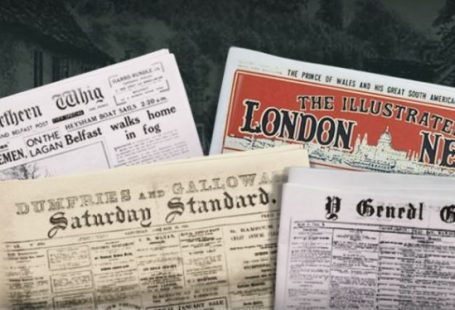Over the past seven days at The Archive we have added 199,758 brand new pages to our collection, including updates to 18 of our existing titles from England, Scotland, Wales and beyond.
Meanwhile, we have added an amazing 140,396 new pages to our special international title the Civil & Military Gazette (Lahore), which traces its origins all the way back to 1845. Read on to find out more about this newspaper title that helps us to tell the story of India and Pakistan under British colonial rule, the struggle for independence and much more, as well as to discover how the newspaper reported on the arrest of Mahatma Gandhi one hundred years ago.
Register now and explore the Archive
Here at The Archive we have been adding to our collection of international titles, which incorporate British Commonwealth countries. These newspapers tell the stark and often confronting story of British colonial rule from the eighteenth century onwards, from the height of the British Empire, to such British-ruled state’s struggle for independence. One of these newspaper titles is the Civil & Military Gazette (Lahore), to which we have added over 100,000 pages this week, with updates spanning the years 1845 to 1930.
The Civil & Military Gazette traces its roots back to 1845, with the publication of The Mofussilite in Calcutta (now Kolkata) in West Bengal. The first edition of The Mofussilite, which you can find here, appeared on 2 August 1845 at the cost of one rupee, and filled 20 pages. Founded by Australian author and journalist John Lang (1816-1864), famed for being Australia’s first native born novelist, the new newspaper was aimed ‘at English speaking military and civil employees of various British enterprises in India and especially those living up-country.’

Indeed, the name Mofussilite was derived from the word ‘mofussil,’ or one who lives in the rural or provincial districts of India. And The Mofussilite carried news from across India, from Madras (Chennai) and Bombay (Mumbai), and the ‘native states,’ or those areas of the region not under British control, as well as from further afield, from the likes of Ceylon (Sri Lanka), Madagascar and Europe. The publication also contained government notifications, for example orders from the Government of Bengal, as well as notices of ‘Domestic Occurrences,’ such as births, marriages and deaths.
Meanwhile, The Mofussilite had an emphasis on literature, featuring original poetry as well as works by founder John Lang. The first edition of the newspaper included a version of Lang’s ‘Fisher’s Ghost’ story, a tale for which he would become most known.
In 1846 John Lang moved to Meerut in Uttar Pradesh, which lies north east of Delhi, taking The Mofussilite with him. Three years later, in 1849, Lang became editor and proprietor of the paper. According to Nena Bierbaum in The Shadow of the Precursor, Lang would refer to The Mofussilite and fellow newspaper the Delhi Gazette as being ‘by far the most remunerative of any newspapers in the East.’

On 10 May 1857 Meerut was home to the beginnings of the Indian Rebellion of 1857, which saw widespread revolt against the rule of the British East India Company. Due to the rebellion, publication of The Mofussilite was temporarily halted, but the newspaper, according to author Alex Tickell, was ‘supremely dismissive of Liberal opinion in Britain’ and of the rebellion itself.
The rebellion was brought to an end when the rebels were defeated at Gwalior on 20 June 1858. The governance of India was handed over to the British crown, marking the beginning of the British Raj. It is estimated that over 800,000 Indians died as a result of the rebellion, from the disease and the famines which both preceded and followed it.
The Mofussilite, however, survived the rebellion and was then published in Agra, also in Uttar Pradesh. Its founder John Lang died in 1864 at the Mussoorie hill station, but his newspaper continued to be published after his death. Meanwhile, in 1872 a new newspaper the Civil and Military Gazette was founded in Lahore and Simla (Shimla). In 1874 this newspaper was bought by George Allen, William Rattigan and James Walker, who moved the concern solely to Lahore.
And it was in 1877 that the three also bought The Mofussilite, closing down its Agra office and consolidating their newspaper concerns in the same Lahore office. And so The Mofussilite became amalgamated with the Civil and Military Gazette, a new version of the newspaper appearing on 2 January 1877 which noted that The Mofussilite was now ‘incorporated’ within it.

Perhaps the Civil and Military Gazette’s biggest claim to fame is that it was where author Rudyard Kipling first worked, at the age of just sixteen. He came to work for the newspaper in 1882, and it was in the Civil and Military Gazette that he published his first set of stories, ‘Plain Tales from The Hills.’ Kipling left the newspaper in 1887 to work for its sister publication The Pioneer.
Meanwhile, the Civil and Military Gazette was published daily, concurrently in Lahore, Simla and Karachi. It ran until 1963, its last editor being Abdul Hamid Sheikh. Working for the newspaper in its last year of publication was veteran Pakistani journalist Mahbub Jamal Zahedi, who for fifty years was editor of Dubai newspaper the Khaleej Times, and was also the news editor of the Karachi based newspaper Dawn.
We have also added more pages this week to the Australian and New Zealand Gazette, which although published in London, aimed to ‘provide for the use of the merchant, the shipper, and the intending emigrant, a permanent record of all the events of importance passing in the whole of the Australian settlements as well as in New Zealand.’ This title was first published on 19 October 1850, and was a ‘Fortnightly Summary of Intelligence from New South Wales, Van Diemen’s Land, South Australia, Port Phillip, Western Australia, and New Zealand.’

Meanwhile, we’ve also added new pages to a selection of Scottish titles, including the West Lothian Courier, the Kilmarnock Standard and the Wishaw Press, as well as to Welsh newspaper the Carmarthen Journal. In addition to these updates, new pages have also joined our titles from across England, from the Harlow Star to the Liverpool Evening Express, from the Wokingham Times to the Brentwood Gazette.
The Arrest of Gandhi – March 1922
In March 1922, Mohandas Karamchand Gandhi, also known by his honorific title of Mahatma (Sanskrit for ‘great-souled’ or ‘venerable’), was arrested for sedition. Gandhi, having returned from South Africa where he had lived and worked from 1893 until 1915, had begun working to achieve independence for India from British rule seven years previously. Advocating non-violent resistance methods, he became the leader of the Indian National Congress in 1921.

But on 12 March 1922, the Civil & Military Gazette reported how ‘Mr. Gandhi has been arrested at Ahmedabad last evening.’ He had been arrested for sedition, or in other words, for inciting rebellion. And in expectation of his arrest, Gandhi had written in publication Young India, that the ‘people should remain unmoved and fulfil the whole of the constructive programme framed at Bardoli with clockwork regularity and with the speed of the Punjab express.’
The programme agreed to at Bardoli was one of widespread civil disobedience, the Gujarat town having been selected to launch a civil disobedience campaign in 1922, which did not go ahead.
Meanwhile, on 14 March 1922 the Civil & Military Gazette went into further detail about Gandhi’s arrest, describing how:
Mr. Mohandas Karamchand Gandhi was arrested at Ahmedabad on the evening of the 10th instant on a charge of sedition under section 124-A, I.P.C, by order of the Bombay Government with the concurrence of the Government of India.

Indeed, Gandhi and Shankarlal Banker, with whom he was arrested, ‘were aware of their impending arrest.’ Shankarlal Banker (1889-1985), an early associate of Gandhi and a fellow Indian independence activist, was the editor of Young India, where Gandhi’s alleged sedition had been published. Banker and fellow Gandhi associate Anasuya Sarabhai (1885-1972), a pioneer ofthe Indian women’s labour movement, were on the way to meet with Gandhi when:
At 10 p.m…. they met Mr. Healy, District Police Superintendent, who showed them warrants and asked them to inform Mr. Gandhi. The news was communicated to Mr. Gandhi who was then taking his bath. When Mr. Gandhi came out he called the Ashram people, took the Gita and prayed together. After that he went to Mr. Healy who was standing outside. Anasuya desired to accompany Mr. Gandhi and Mr. Banker, as she said both were unwell. Mr. Healy expressed his inability to accede to the request, but allowed her and Mrs. Gandhi to accompany them as far as Sabarmati Jail, where both accused are detained.
The same article related how the trial was due to commence on 14 March 1922 at ‘Shahebag in the Commissioner’s bungalow, before Mr. Brown, Assistant Collector,’ and there was, at least according to the Civil and Military Gazette, no ‘hartal and no demonstrations’ in Ahmedabad. Hartal is a form of mass protest that came into being during the struggle for Indian independence, and featured shutdown of workplaces, as well as schools.

Meanwhile, the Civil and Military Gazette reported how in England news of Gandhi’s arrest met ‘with wide approval; though the action of the authorities in this matter is regarded as most tardy.’ Indeed, it was allegedly hoped that the arrest was a ‘sign of the inauguration of a new policy in India.’
Elsewhere in the world the news was not met with the same approval. The Civil and Military Gazette contained this report from Nairobi:
Following Gandhi’s arrest the Indians of Mombasa held a hartal, and a mass meeting passed a resolution sympathising with Gandhi’s wife and congratulating Mr. Gandhi.

The trial of Gandhi and Shankarlal Banker begun on 14 March 1922, the Civil and Military Gazette relating how:
They were tried for four articles in ‘Young India,’ two which were under the headings of ‘Disaffection a Virtue’ and ‘Shaking the Manes.’ Both accused said they would plead guilty to the charge at the proper time. The Magistrate then framed charges under section 124-A (Sedition).
Across India the news of Gandhi’s arrest and trial was spreading, and according to the Civil and Military Gazette ‘some excitement’ greeted the news in Calcutta (Kolkata), although ‘nothing untoward happened.’ Meanwhile in Allahabad, in Uttar Pradesh, a ‘partial short lived hartal’ was held, and in Madras (Chennai) there was:
…a mild demonstration on Triplicane Beach, yesterday, when there was a bonfire of foreign clothes, including Lawyers’ gowns, silk chudders, caps and valuable lace cloths.

It is evident that the Civil and Military Gazette is trying to play down the impact of Gandhi’s arrest, appealing to the British audience for which it had been set up some eighty years before. This is further exemplified by its report on how the city of Lahore received the news of his conviction for sedition, which led to Gandhi spending six years in prison.
The Civil and Military Gazette reported on 21 March 1922 how the Provincial Congress Committee had decided to ‘observe hartal on the receipt of the news’ of Gandhi’s conviction, and so ‘accordingly men were dispatched throughout the city to proclaim the sentence inflicted upon Mr. Gandhi and to enjoin people to observe hartal on Sunday and keep a fast.’ But the newspaper described how:
Hartal was but partially observed. The main bazaars were closed but Kashmiri and Mochi Gates and other streets with a predominant Mussalman population opened in the morning. Pandit Ram Bhaj Dutt and some Khilafat workers patrolled the city requesting the shopkeepers to close, some of whom complied and others refused. The hartal concluded with the burning of some garments of foreign cloth on the Ravi.
Please note here the archaic and outmoded language of the time in reference to the word ‘Mussalman,’ an archaic word for Muslim.

The newspaper also published on the same day ‘Farewell Messages’ from Gandhi himself, who declared that ‘if people abandon non-violence he will prefer to remain in jail.’ It also reported how although his wife Kasturba was ‘grieved’ at the sentence, she was:
…consoled at the thought that her countrymen and countrywomen will carry out the precepts of her husband, viz., non-violence and khaddar, and get him released only through complete carrying out of the Bardoli-Delhi programme.
And so Gandhi begun his prison sentence, the Civil and Military Gazette providing a somewhat partisan account of this extremely important moment in the struggle for Indian independence.
Updated Titles
This week we have updated 18 of our existing titles.
You can learn more about each of the titles we add to every week by clicking on their names. On each paper’s title page, you can read a FREE sample issue, learn more about our current holdings, and our plans for digitisation.
| Title | Year Range |
| Australian and New Zealand Gazette | 1855, 1864 |
| Brentwood Gazette | 1988-1989 |
| Carmarthen Journal | 1993 |
| Civil & Military Gazette (Lahore) | 1845, 1847-1876, 1913-1928, 1930 |
| Gloucester Citizen | 1986 |
| Hammersmith & Shepherds Bush Gazette | 1970, 1972 |
| Harlow Star | 1986, 1989 |
| Hinckley Times | 1987 |
| Ilfracombe Chronicle | 1872 |
| Kilmarnock Standard | 1987 |
| Liverpool Daily Post | 1874 |
| Liverpool Evening Express | 1899 |
| Macclesfield Express | 1991 |
| Rutherglen Reformer and Cambuslang Journal | 1887 |
| Staffordshire Newsletter | 1988 |
| West Lothian Courier | 1989 |
| Wishaw Press | 1993 |
| Wokingham Times | 1993 |
You can keep up to date with all the latest additions by visiting the recently added page. You can even look ahead to see what we’re going to add tomorrow.






